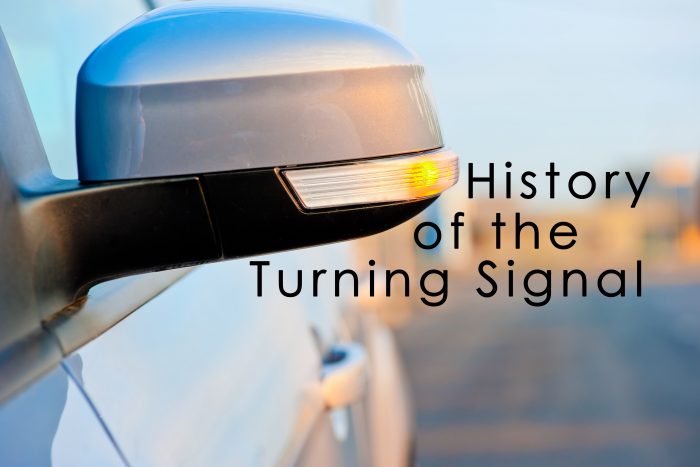History of the Turning Signal

History of the Turning Signal
There’s a amazing invention that not all of us know about. It’s an incredible concept: communicating with other people who are in different cars. Can you believe this? Even more amazing–this invention is in the palm of your hand. There’s a lever behind your steering wheel; if you push it down, it signals to the drivers around you that you are turning left. When pushed up, the signal indicates that you are turning right. This awesome form of communication helps navigate the flow of traffic and prevent accidents.
This gift of communication was not always built into our vehicles. In the early 1900s, turning signals were done by putting your arm out your car window. To indicate a left turn, you’d put your arm straight out the window. To indicate a right turn, your arm is turned up at a right angle. To indicate that you are stopping, you would put your arm down at a right-hand angle. Bicyclists use these signals to this day. Luckily, there’s no more putting your arm out of the window of your car in the rain/snow to communicate with other drivers. Now, we can use the built-in turning signal.
Numerous people had the idea of providing an easier way to signal your next move. According to secondchancegarage.com, in 1907, a man named Percy Douglas-Hamilton got a patent for a device that simplified the communication of turning in vehicles. The original lights were shaped like hands. The hand signals were similar to the ones already being used, making it easy for other drivers to read. Nearly a decade later, a successful, silent-film actress named Florence Lawrence had a similar idea. Due to her success in acting, she was able to buy a car which she adored. In 1914, she designed a mechanical arm that moved a flag on the car’s rear bumper by the press of a button. The flag was either raised or lowered depending on the direction the car was going. Though she designed this invention, she did not patent it.
Another patented invention came in 1925 by a man named Edgar A. Walz Jr., which is known as the first modern-style turn signal. After trying and failing to sell the invention to car manufacturers, the patent expired after fourteen years.
As a matter of fact, Buick was the first car manufacturer in the United States to offer flashing turn signals installed in the vehicle. Buick put these vehicles on the market in 1939. These original turn signals only flashed on the rear lights. It wasn’t until 1940 that Buick began to manufacture vehicles with the signals extending to the front lights as well. The article on secondchancegarage.com informs us that the turning signal was advertised as a “Flash-Way Directional Signal.” Interestingly, in the beginning, these lights were optional on cars–for an additional cost.
Turning signals on vehicles continued to evolve throughout the years. However, the modern technology of turning signals has remained the same since around the 1980s.
Do you have questions about your insurance? Find an insurance agent near you with our Agent Finder
Search All Blogs
Search All Blogs
Read More Blogs
Beyond Boredom: Unearthing the Surprising Stories Behind Our Favorite Board Games
Game night secrets revealed! Discover the surprising origins and quirky facts behind your beloved board games.
Avoiding the Pitfalls: Common Mistakes of At-Home Businesses
Launch your home business right! Learn to avoid the common errors that can derail your entrepreneurial dreams.
Your Life Insurance Recipe: Crafting the Perfect Blend for Your Family’s Future
Find your perfect life insurance mix: Learn how to blend term and permanent policies for optimal family protection.
From Ford’s Innovation to Today’s Marvel: Unveiling the Secrets of Modern Car Production
Beyond the assembly line: Discover the surprising speed, customization, and quality checks involved in modern car manufacturing.
Beyond Pizza and Promises: Recognizing When It’s Time to Hire Professional Movers
Time to call the pros? Learn when pizza and beer just won’t cut it for your next move.
Mapping Our Roots: Uncovering the Stories Behind American City Names
City names revealed! Discover the historical, religious, and geographical influences behind the monikers of American cities.
The Agile Approach: Why Short, Focused Plans Are Overtaking the Mammoth Business Blueprint
Ditch the doorstop plan! Discover why concise, adaptable strategies are the new gold standard for business success.
Embracing Tomorrow: The Practical Power of Planning for Life’s Only Certainty
Face the future with confidence: Understand how planning for life’s only certainty with life insurance can provide lasting security.
Steering Your Savings: Taking Control of Your Car Insurance Rates
You’re in the driver’s seat! Learn how your credit, driving habits, vehicle choice, and smart shopping can lower your car insurance costs.
Underfoot Upgrade: Transforming Your Garage Floor from Forgotten to Fantastic
Don’t ignore your garage floor! Discover easy and impactful ways to upgrade this often-neglected area of your home.










